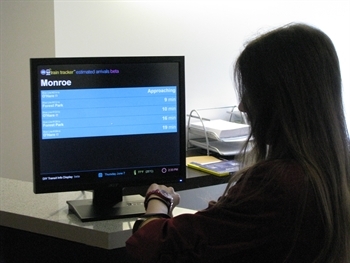
Steven Vance
Accurate trackers on bus shelters have increased ridership and rider satisfaction.
Did you know? Chicago schools in neighborhoods with high crime rates have installed Bus Tracker to keep students safer by avoiding standing at the bus stop for long periods of time.
Regular riders of transit love the convenience of tools like Chicago Transit Authority’s (CTA) Bus and Train Tracker. Using GPS technology and historical route data, these services provide real-time bus and train arrival information for a specific stop or station. Trackers count down the minutes until the next arrival, conveniently delivering that information to riders via text messages, mobile web sites, and at a growing number of train platforms, bus stops, and even some local businesses. They make it easier for riders to plan trips and minimize wait times and missed connections, eliminating the biggest hassle in riding transit: wondering when the next bus or train will arrive. CTA isn’t the only system using this type of technology. Washington, D.C., Berlin, Hamburg, London, and Portland, Ore., are just some of the cities across the globe using trackers to increase riders’ satisfaction.
It’s been theorized that transit trackers keep current riders riding; but do they entice new riders? It’s a worthy question, especially considering the upsurge in transit ridership nationwide and particularly in Chicago, the city with one of the most comprehensive transit tracker systems. A new study answers this question: Ridership effects of real-time bus information system: A case study in the City of Chicago, by MacroSys, LLC’s Lei Tang and Vonu Thakuriah, of the University of Illinois at Chicago, finds that when controlling for outside factors that influence transit ridership –for example when gas prices spike and people switch from driving to transit – the CTA Bus Tracker has, in fact, attracted new riders.

MPC staff check the Transit Tracker for their homeward commutes.
John P. Beall
CTA’s bus tracker was implemented incrementally on all bus routes between August 2006 and May 2009. Tang and Thakuriah analyzed average weekday ridership on every CTA bus route before and after Bus Tracker was implemented between January 2002 through December 2010. They found that Bus Tracker increased CTA bus ridership by 1.8 percent to 2.2 percent, depending on the route. The researchers also accounted for outlying factors such as employment and population fluctuations, arrival frequency, gas prices, and weather. While 2 percent may seem a modest gain, it translates to an impressive 6.2 million more bus trips per year and almost $14 million more in fare revenues for the CTA (assuming each new rider paid the full cash fare). It also means many more drivers – and their idling, polluting cars – are off Chicago’s congested roads and highways.
Trackers in Chicago have come a long way since 2006. In January 2011, CTA introduced Train Tracker, providing arrival times on all eight rail lines. In September 2011, the CTA began the installation of more than 400 LED Bus Tracker displays at bus stops and in stores and restaurants throughout the city. Each sign shows when the next four busses will arrive and makes an audible announcement of how long the wait is for the next bus, which is particularly helpful for visually impaired riders. The CTA also makes data available to developers interested in building web and mobile apps, sparking the creation of very useful third-party apps, while saving the agency from using its resources to build them.
Thanks to Tang and Thakuriah’s study, we now know these trackers are changing people’s behaviors and encouraging more people to use transit. It’s no wonder: Providing reliable transit information eliminates uncertainty, which in turn reduces riders’ stress because they no longer have to wonder when the next bus will arrive. Riders also can plan ahead and feel safer by avoiding long wait times at unsavory stops. These trackers also may lead to greater revenue for small businesses, because if riders know they have a few minutes before the next train or bus, they might buy a cup of coffee or a magazine instead of waiting on the platform or stop. With the answer to “Where’s my train” at the tap of a button, it’s likely that transit ridership – and all of its benefits – will grow.
Get In the Loop on all the latest local, national and international transit headlines.